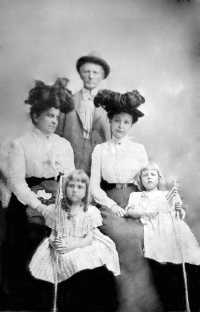Sign up for the Family Tree Newsletter Plus, you’ll receive our 10 Essential Genealogy Research Forms PDF as a special thank you!
Get Your Free Genealogy Forms
"*" indicates required fields

Robert Niles owns two identical tintypes mounted in paper folders. He thinks he knows the identity of all the individuals but isn’t sure. He also wants to know how a copy was made of the original tintype.
Tintypes are an American invention, first patented by Hamilton Lamphere Smith of Ohio on Feb. 19, 1856. This photographic method was an improvement on earlier types of photographs: daguerreotypes, also on metal, and ambrotypes, on glass. Early tintypes were placed in cases like ambrotypes and daguerreotypes, but could also be sold with a paper mount. Although called tintypes, these photographs are on iron sheets and are also known as ferreotypes.
The Civil War made tintypes quite popular because they were inexpensive to produce and could be easily mailed home with a letter. Itinerant photographers traveled with the troops, offering soldiers opportunities to take multiple images to send to family or swap with friends. Tintypes remained popular until early in the 20th century and can even be found today in resort areas, where tourists have their portraits taken in historical dress. The history and development of the tintype are fascinating. More details are available in The American Tintype by Floyd and Marion Rinhart and Robert W. Wagner (Ohio State University Press, $75).
Tintypes came in a variety of sizes, from a gem or thumbnail (1-inch square) to a full plate (6×8 inches). The tintypes owned by Robert Niles are known as a sixth plate (2×3 inches).
Robert Niles was curious about owning two identical tintypes. It was possible for tintype studios to take multiple images using one camera with several lenses Therefore, Robert Niles’ second image is not a copy, but another photo taken simultaneously.
This lovely group portrait resembles a tintype covered in an earlier column in which a family posed with a flag (see Patriotic Clues). In that instance, the flag helped date the image, but here the flag details are not visible or useful as a dating clue.
Once again it is clothing evidence that provides a time frame for our image. The large hats worn by the women as well as their blouses and skirts place this photograph within the first decade of the 20th century. Robert Niles suggested a date of 1901, which is quite possible. This year enabled him to identify all but one of the subjects by comparing this picture with other portraits of the same individuals and life dates.
In this portrait are two children, their parents and another woman. Left to right: Johanna Paula (Hess) Fleck, born Jan. 6, 1874, wife of Charles Fleck; Charles (Carl) Heinrich Joseph Fleck, born Oct. 20, 1851; unknown younger woman; and the two girls, Ruth Amelia Fleck (born 1894) and Mabel Paula Fleck (born 1896). The identity of the younger woman is a little mysterious. An elderly relative who knew the family identified her as Amelia Helena (Steinway) Wagstaff, Charles Fleck’s stepsister.
Captured in this image is a family outing on a summer’s day. The movement in the flags is either due to the girls waving them or to a breeze in an outdoor studio. Whatever the occasion, it is a beautiful portrait of a couple, their children and another relative. If you recognize the young woman on the right, please e-mail me at mtaylor@taylorandstrong.com.
Find out how to submit your own picture for possible analysis by Maureen Taylor.
ADVERTISEMENT

